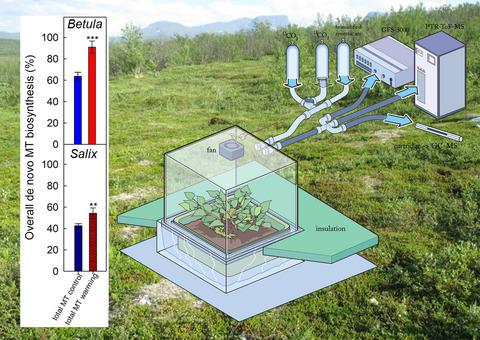当前位置:
X-MOL 学术
›
Glob. Change Biol.
›
论文详情
Our official English website, www.x-mol.net, welcomes your
feedback! (Note: you will need to create a separate account there.)
Origin of volatile organic compound emissions from subarctic tundra under global warming.
Global Change Biology ( IF 10.8 ) Pub Date : 2020-01-20 , DOI: 10.1111/gcb.14935 Andrea Ghirardo 1 , Frida Lindstein 2 , Kerstin Koch 1 , Franz Buegger 3 , Michael Schloter 4 , Andreas Albert 1 , Anders Michelsen 2, 5 , J Barbro Winkler 1 , Jörg-Peter Schnitzler 1 , Riikka Rinnan 2, 5
Global Change Biology ( IF 10.8 ) Pub Date : 2020-01-20 , DOI: 10.1111/gcb.14935 Andrea Ghirardo 1 , Frida Lindstein 2 , Kerstin Koch 1 , Franz Buegger 3 , Michael Schloter 4 , Andreas Albert 1 , Anders Michelsen 2, 5 , J Barbro Winkler 1 , Jörg-Peter Schnitzler 1 , Riikka Rinnan 2, 5
Affiliation

|
Warming occurs in the Arctic twice as fast as the global average, which in turn leads to a large enhancement in terpenoid emissions from vegetation. Volatile terpenoids are the main class of biogenic volatile organic compounds (VOCs) that play crucial roles in atmospheric chemistry and climate. However, the biochemical mechanisms behind the temperature-dependent increase in VOC emissions from subarctic ecosystems are largely unexplored. Using 13 CO2 -labeling, we studied the origin of VOCs and the carbon (C) allocation under global warming in the soil-plant-atmosphere system of contrasting subarctic heath tundra vegetation communities characterized by dwarf shrubs of the genera Salix or Betula. The projected temperature rise of the subarctic summer by 5°C was realistically simulated in sophisticated climate chambers. VOC emissions strongly depended on the plant species composition of the heath tundra. Warming caused increased VOC emissions and significant changes in the pattern of volatiles toward more reactive hydrocarbons. The 13 C was incorporated to varying degrees in different monoterpene and sesquiterpene isomers. We found that de novo monoterpene biosynthesis contributed to 40%-44% (Salix) and 60%-68% (Betula) of total monoterpene emissions under the current climate, and that warming increased the contribution to 50%-58% (Salix) and 87%-95% (Betula). Analyses of above- and belowground 12/13 C showed shifts of C allocation in the plant-soil systems and negative effects of warming on C sequestration by lowering net ecosystem exchange of CO2 and increasing C loss as VOCs. This comprehensive analysis provides the scientific basis for mechanistically understanding the processes controlling terpenoid emissions, required for modeling VOC emissions from terrestrial ecosystems and predicting the future chemistry of the arctic atmosphere. By changing the chemical composition and loads of VOCs into the atmosphere, the current data indicate that global warming in the Arctic may have implications for regional and global climate and for the delicate tundra ecosystems.
中文翻译:

全球变暖下北极苔原挥发性有机化合物排放的来源。
北极变暖的速度是全球平均水平的两倍,这反过来导致植被中萜类化合物的排放量大大增加。挥发性萜类化合物是在大气化学和气候中起关键作用的生物挥发性有机化合物(VOC)的主要类别。然而,北极地区生态系统中挥发性有机化合物排放量随温度变化而增加的背后的生化机制尚待探索。我们使用13种CO2标记,研究了全球气候变暖下土壤-植物-大气系统中VOC的起源和碳(C)的分布,该土壤-植物-大气系统形成了以柳柳属或桦属矮化灌木为特征的北极亚热带荒漠苔原植被群落。在复杂的气候箱中,实际模拟了北极夏季预计的5°C温升。VOC的排放在很大程度上取决于荒漠苔原的植物种类组成。变暖导致VOC排放增加,并且挥发物形态向着更具反应性的碳氢化合物方向变化很大。13 C在不同的单萜和倍半萜异构体中以不同程度掺入。我们发现,在当前气候下,从头生物单萜的生物合成占总单萜排放量的40%-44%(Salix)和60%-68%(Betula),而变暖则将这一贡献增加到50%-58%(Salix)和87%-95%(桦木)。地上和地下12/13 C的分析表明,植物-土壤系统中C的分配发生了变化,并且变暖通过降低生态系统净二氧化碳交换量并增加了作为VOC的C的损失而对C的固存产生了负面影响。这项全面的分析为机械地理解控制类萜排放的过程提供了科学依据,这些过程是对来自陆地生态系统的VOC排放进行建模并预测北极大气未来化学反应所必需的。通过改变进入大气中的挥发性有机化合物的化学成分和负荷,目前的数据表明,北极的全球变暖可能对区域和全球气候以及脆弱的苔原生态系统产生影响。
更新日期:2020-01-21
中文翻译:

全球变暖下北极苔原挥发性有机化合物排放的来源。
北极变暖的速度是全球平均水平的两倍,这反过来导致植被中萜类化合物的排放量大大增加。挥发性萜类化合物是在大气化学和气候中起关键作用的生物挥发性有机化合物(VOC)的主要类别。然而,北极地区生态系统中挥发性有机化合物排放量随温度变化而增加的背后的生化机制尚待探索。我们使用13种CO2标记,研究了全球气候变暖下土壤-植物-大气系统中VOC的起源和碳(C)的分布,该土壤-植物-大气系统形成了以柳柳属或桦属矮化灌木为特征的北极亚热带荒漠苔原植被群落。在复杂的气候箱中,实际模拟了北极夏季预计的5°C温升。VOC的排放在很大程度上取决于荒漠苔原的植物种类组成。变暖导致VOC排放增加,并且挥发物形态向着更具反应性的碳氢化合物方向变化很大。13 C在不同的单萜和倍半萜异构体中以不同程度掺入。我们发现,在当前气候下,从头生物单萜的生物合成占总单萜排放量的40%-44%(Salix)和60%-68%(Betula),而变暖则将这一贡献增加到50%-58%(Salix)和87%-95%(桦木)。地上和地下12/13 C的分析表明,植物-土壤系统中C的分配发生了变化,并且变暖通过降低生态系统净二氧化碳交换量并增加了作为VOC的C的损失而对C的固存产生了负面影响。这项全面的分析为机械地理解控制类萜排放的过程提供了科学依据,这些过程是对来自陆地生态系统的VOC排放进行建模并预测北极大气未来化学反应所必需的。通过改变进入大气中的挥发性有机化合物的化学成分和负荷,目前的数据表明,北极的全球变暖可能对区域和全球气候以及脆弱的苔原生态系统产生影响。











































 京公网安备 11010802027423号
京公网安备 11010802027423号